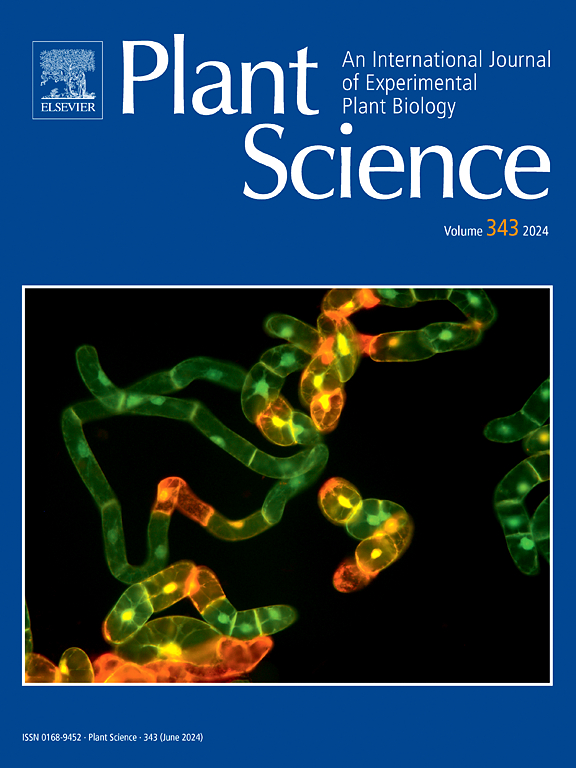R2R3-MYB转录因子LmMYB111正调控金银花绿原酸和木犀草苷的生物合成
IF 4.2
2区 生物学
Q2 BIOCHEMISTRY & MOLECULAR BIOLOGY
引用次数: 0
摘要
金银花是我国传统医学中常用的重要药材。绿原酸(CGA)和木犀草苷是芒萁中最重要的活性成分。虽然CGA和木犀草苷的生物合成途径和结构基因已被广泛阐明,但其转录调控尚不清楚。本研究通过对转录组和代谢组的整合,发现R2R3-MYB转录因子LmMYB111与CGA浓度正相关,与AtMYB111同源性密切,并作为转录激活因子。LmMYB111在烟草和忍冬中的过表达导致CGA和木犀草苷的产量增加。RNA-Seq结果显示,LmMYB111过表达显著上调CGA和木黄酮苷生物合成基因,包括10个pal、3个C4Hs、7个4cl、4个HCT/HQTs、3个CHSs和5个CHIs。DNA亲和纯化测序(app - seq)揭示了LmMYB111和1135个下游靶点的结合基序,包括结构基因PAL1/PAL4s、C4H、4CL2、CHI和DFR,以及转录因子MYB3/MYB4、bHLH62/TT8、BEL1、SCL15/SCL32和ERF3。电泳迁移率转移试验(EMSA)和双荧光素酶报告系统(DLR)进一步证明LmMYB111结合并激活了proLmMYB4、prolmmpal1、proLm4CL2、proLmCHI和proLmDFR,从而促进了CGA、木黄酮苷等酚类物质的超积累。这些发现揭示了LmMYB111通过控制结构基因和TFs的表达,参与了大白蚁CGA和木犀草苷生物合成调控网络,并将有助于通过基因工程提高酚类物质的产量。本文章由计算机程序翻译,如有差异,请以英文原文为准。
A R2R3-MYB transcription factor LmMYB111 positively regulates chlorogenic acid and luteoloside biosynthesis in Lonicera macranthoides
Lonicera macranthoides is a vital medicinal herb frequently used in Chinese traditional medicine. Chlorogenic acid (CGA) and luteoloside are the most crucial bioactive pharmaceutical ingredients in L. macranthoides. Although CGA and luteoloside biosynthetic pathway and structural genes appeared to be extensively elucidated, the transcriptional regulation has yet to be unveiled. Here, integration of transcriptome and metabolome revealed a R2R3-MYB transcription factor LmMYB111 positively correlated with CGA concentration, which shares close homology with AtMYB111 and acts as a transcriptional activator. Overexpressing LmMYB111 in tobacco and Lonicera resulted in enhanced production of CGA and luteoloside. RNA-Seq demonstrated that overexpression of LmMYB111 dramatically upregulated CGA and luteoloside biosynthetic genes, including 10 PALs, 3 C4Hs, 7 4CLs, 4 HCT/HQTs, 3 CHSs and 5 CHIs. DNA Affinity Purification sequencing (DAP-Seq) revealed the binding motifs of LmMYB111 and 1135 downstream targets, including structural genes e.g. PAL1/PAL4s, C4H, 4CL2, CHI, and DFR as well as several transcription factors (TFs), e.g. MYB3/MYB4, bHLH62/TT8, BEL1, SCL15/SCL32 and ERF3.The electrophoretic mobility shift assay (EMSA) together with dual-luciferase reporter system (DLR) further proved that LmMYB111 bound to and activated proLmMYB4, proLmPAL1, proLm4CL2, proLmCHI and proLmDFR, therefore facilitating hyperaccumulation of CGA, luteoloside and other phenolics. These findings shed light on the participation of LmMYB111 in CGA and luteoloside biosynthetic regulatory networks in L. macranthoides mediated by controlling the expression of structural genes and TFs, which will contribute to elevate phenolics production by genetic engineering.
求助全文
通过发布文献求助,成功后即可免费获取论文全文。
去求助
来源期刊

Plant Science
生物-生化与分子生物学
CiteScore
9.10
自引率
1.90%
发文量
322
审稿时长
33 days
期刊介绍:
Plant Science will publish in the minimum of time, research manuscripts as well as commissioned reviews and commentaries recommended by its referees in all areas of experimental plant biology with emphasis in the broad areas of genomics, proteomics, biochemistry (including enzymology), physiology, cell biology, development, genetics, functional plant breeding, systems biology and the interaction of plants with the environment.
Manuscripts for full consideration should be written concisely and essentially as a final report. The main criterion for publication is that the manuscript must contain original and significant insights that lead to a better understanding of fundamental plant biology. Papers centering on plant cell culture should be of interest to a wide audience and methods employed result in a substantial improvement over existing established techniques and approaches. Methods papers are welcome only when the technique(s) described is novel or provides a major advancement of established protocols.
 求助内容:
求助内容: 应助结果提醒方式:
应助结果提醒方式:


